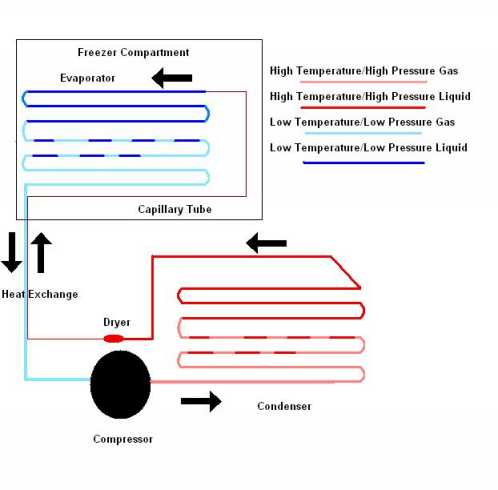How Refrigerators Work
Knowing how refrigerators work can be very useful when
working on refrigerators. On this page I will explain how they work so that you
can use this page in conjunction with my refrigerator repair guide to help you
fix your broken refrigerator.
Refrigeration
In order for a refrigerator to work, refrigeration must take place. Refrigeration takes place in the sealed system. The sealed system consists of the compressor, condenser, metering device evaporator and suction tube. First a refrigerant such as R-134 or R-12 enters into the compressor in gas form and the compressor raises the pressure and the temperature of the gas. Then the gas enters the condenser (normally located under or behind the refrigerator) still in gas form and exits as a liquid. Next, the high pressure/high temperature liquid refrigerant enters a metering device or capillary tube on most refrigerators and exits as a low pressure/ low temperature liquid. Next, the low pressure/low temperature liquid refrigerant enters the evaporator (located inside the freezer) and exits as a low pressure/low temperature gas. Then finally enters the suction tube and exits into the compressor and the process starts all over. Refrigerators never run out of gas so this process can go on forever unless the gas leaks out.

Airflow
Airflow is important in the operation of
refrigerators. The evaporator is located inside the freezer and provides cold
air for the fresh food section and the freezer. A fan located above the
evaporator blows air into the freezer and the fresh food section. The air enters
the fresh food section through an air duck. A damper controls the rate of
airflow into the fresh food section. Some dampers are manually turned by hand
and some dampers are controlled by an electric motor. There is also a fan under
the refrigerator to provide airflow through the condenser and over the
compressor. This helps with the condensing process and helps cool the compressor
so that it doesn’t overheat. If airflow is stopped or blocked inside or outside
the refrigerator, the refrigerator stops working properly.
Defrost
During a defrost cycle, the
refrigeration is cut off and a defrost heater comes on to melt the ice off the
evaporator. Once the temperature reaches 47-50 degrees Fahrenheit, the defrost
thermostat terminates the defrost cycle. If you didn’t have a defrost cycle the
ice would eventually build up to the point that it blocks airflow. Refrigerators
go through a defrost cycle anywhere from once every six hours to once every 48
hours depending on the defrost control. There are two types of defrost controls,
adaptive defrost controls and mechanical defrost timers.
That’s the basics on how refrigerators work now a little on how they are
controlled.
Refrigerator Controls
Adaptive Defrost
Controls
Refrigerators uses more electricity during defrost than
any other cycle, so to make refrigerators more efficient manufactures started
using adaptive defrost controls. An adaptive defrost control adapts the defrost
cycle to your families needs. The more times the doors of your refrigerator are
opened, the more often it needs a defrost cycle. On GE refrigerators with
adaptive defrost, it goes through a defrost cycle once every 48 hours if the
doors are not opened during that time. But the longer the door stays open
between defrost cycles, the more often it goes into a defrost cycle.
Mechanical Defrost Timers
Unlike adaptive
defrost controls, the time between defrost cycles is the same on refrigerators
with a mechanical defrost timer. The time between defrost cycles will vary with
each models. Some defrost every six hours for 30 minutes and some defrost every
12 hours for 35 minutes.
Temperature Controls
Refrigerators have two controls, one for the freezer and one
for fresh food. The fresh food control is a thermostat called a cold control
that cuts off the refrigerator when the fresh food section reaches desired
temperature which is somewhere between 33 and 42 degrees Fahrenheit, by that
time the freezer will be cold enough. On older refrigerators and some new
refrigerators, the freezer control controls a damper that slows down or speeds
up the rate that the air enters the fresh food section. So if you turn the
freezer up, all you do is block airflow going to the fresh food section so that
the refrigerator runs longer and the freezer gets colder. Normally it is best if
this control is set midway and left there. On newer refrigerators with an
electric damper control, the damper automatically opens and closes the damper,
as needed depending on the temperature in the fresh food and freezer
sections.
I hope this page helped you better understand how refrigerators
work. If you have any questions about how refrigerators work you can visit my
page on frequently
asked questions about refrigerators.
Return From How Refrigerators Work